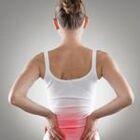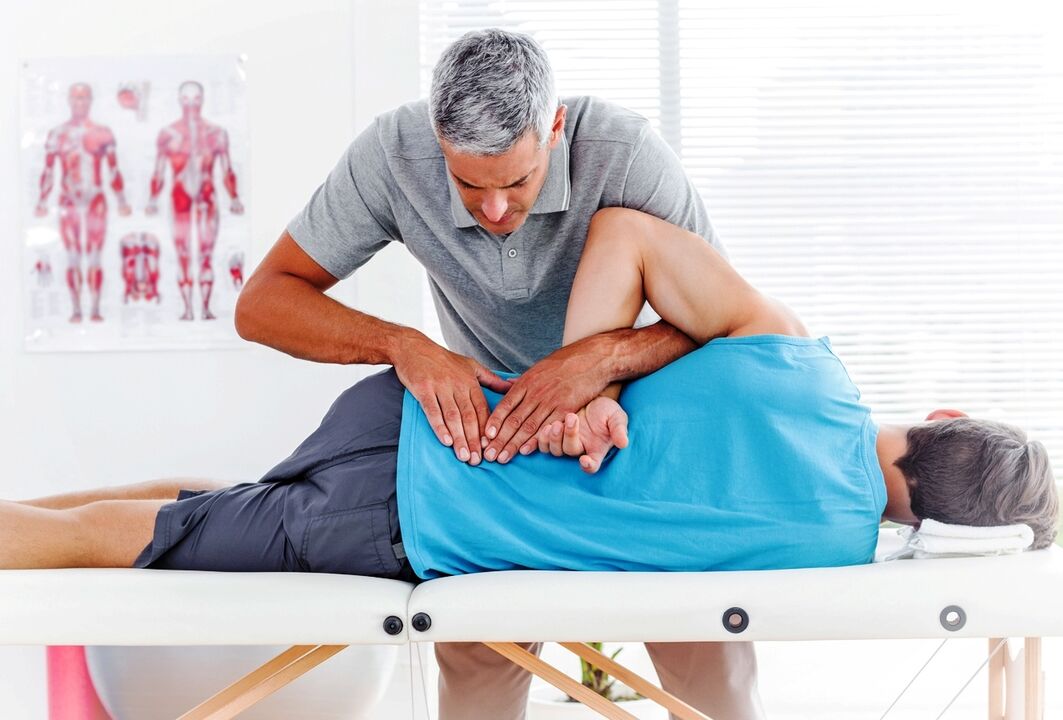
Low painIndicates a disease or damage to the spine, nerve structures, soft tissues, internal organs, with febrile states of various genesis are observed.It is acute, stupid, constant, newspaper, burning, shot, exploded.Sometimes it is associated with physical activity, climate changes.Pathologies, manifested by lower back pain, are diagnosed on the basis of complaints, anamnesis, exam data and additional studies: radiography, magnetic resonance, CT.Before making a diagnosis, peace is necessary, sometimes it is allowed to use ointments, taking analgesics.
Why does your back hurt?
Column diseases
A common cause of lumbar pain are congenital anomalies and the acquired diseases of the spine.The nature of pain syndrome varies.The pain caused directly by the pathological process, often newspaper, local, painful or strap, is associated with the weather, physical activity, remain in an uncomfortable position.
Due to the muscles spasm, lumbago (lateral) is produced, acute pain accompanied by movements restriction.With many pathologies of the spine, lumboyshalgia is observed: pain, ardor or firewood, radiating in the back of the thigh.Painful sensations are often found in root syndrome.It can be detected in the following diseases of the spinal column:
- Degenerative pathologies: osteochondrosis, protuberance of the intervertebral disk, intervertebral hernia, spondyosis, spondillo osteoarthritis.
- Congenital anomalies: Sacralization, lumbalization.
- Polethiological conditions: spondylolis, spondylolist.
- Vascular diseases: Violations of the spinal circulation.
- Other diseases: Foresty disease.
- Secondary Injuries of Nervous Structures: Lumbosacra radiculitis, lumbosacra plexitis, myelopathy of several genesis.

Curvature of the column
Minor or moderate pain pains are observed for all types of curvature of the spine, which is associated with a non -vioological redistribution of the load, over -view of the muscles and ligaments of the back.The pain appears as a result of an uncomfortable body position, sleeps in a bed too hard or too soft.The symptom is accompanied by:
- Lordosis;
- kyphosis;
- scoliosis;
- Kyphhoscoliosis;
- Flat back syndrome.
Osteoporosis
Throwing or pain of painful sensations in the lumbar and thoracic column for a long time are the only symptom of osteoporosis.Pain syndrome expressly expresses itself after loading, before changing climatic conditions.The symptom is observed in the following varieties of osteoporosis:
- postmenopausic;
- Youth;
- idiopathic;
- senile.
Similar pains are detected in patients with secondary forms of pathology, due to genetic diseases, endocrine disorders, chronic poisoning and taking some medications.Secondary osteoporosis can also occur in the context of malabsorption syndrome, liver diseases, KHPN, rheumatoid arthritis, well.
Strengthening pain, increasing pain duration can be associated with the development of a pathological fracture.Other trauma signs are often not expressed, so the fracture often remains without diagnosing.
Column injuries
The most common damage is the spine bruise.In mild cases, the pathology is manifested by moderate pain with low back, intensifying during the movements, local edema and sometimes bruises and hemorrhages.In severe bruises, neurological disorders are added to listed symptoms.
The compression fracture of the lumbar column occurs due to the violent flexion of the body.It is characterized by acute pain, containing breathing at the time of injury.Then, there is an increase in pain in the case of body turns, soft tissue edema is detected.The palpation of the spiny process is painful.Other possible fractures include damage to arches, transverse processes, thorny processes.
In addition, low back pain is found in patients with traumatic spondylolistis and subluxation of vertebrae.Painful sensations are paroxysmal, they resemble lumbago, complemented by a sense of gravity and numbness of the lower extremities.
Soft and kidneys injuries
Soft tissue injury is accompanied by insignificant or moderate local pain that decreases rapidly, a small edema.Hemorrhages are possible.There is no blood in the urine.Renal bruises are manifested by insignificant pain and hematuria in the short term.In the case of renal lesions, painful syndrome is intense, pain radiates to the lower abdomen, groin and genitals.A bruise is visible in the lumbar region.In severe cases, severe pain is observed, prolonged macrohematuria.The shock condition is developed.
Spine infections and spinal cord
Column osteomyelitis can be hematogenous, post -traumatic, contact, postoperative.The acute form of the disease is manifested by rapidly increasing low back pain, combined with chills, fever, poisoning syndrome and deterioration in general conditions.The pain that contracts, explodes, so intense that they avoid any movement, force the patient to freeze in bed.In chronic osteomyelitis, manifestations soften, a fistulous course with a purulent separate course is formed.
The tuberculosis of the spine develops gradually.At first, periodic deep pains are observed, improved after loading, the greatest skin sensitivity in the projection of the affected vertebrae.The rigidity of the march is formed.In the context of the significant destruction of bone structures, the nature of pain changes, since it is caused by the compression of nerve roots.The pain becomes burning, radiates to the legs, complemented by paresthesia, numbness.
In patients with spinal epidural abscess, pain is severe, deep, dumping, combined with chills, hyperthermia, muscle tension.The recording of the thorny processes of the vertebrae is painful.With the progression of the pathology, there are rooster syndrome, then pairsis, pelvic organ disorders are developed.
Local inflammatory processes
Purulent processes in surface tissues and fiber close to the soil are accompanied by intense low back pain.Possible causes of pain syndrome are boils, carbuntas and paranephritis.
In the first two cases, the abscess is formed in the skin, it looks like a limited and very painful seal with a diameter of 1 cm crimson or crimson blue with one or more rods in the center.The pain intensifies rapidly, it becomes a contraction, pulsating, losing the dream.General hyperthermia, insignificant or moderate violation of the general state is observed.
With paranephritis, fever is pronounced at the beginning.Pain syndrome develops after 2-3 days.The pains are very intense, they can be given to the stomach or hypochondrium, intensify when walking, movements, deep breathing.In some forms of paranephritis due to pain, the patient takes a forced position.Lumbar muscles are tense.Edema, local hyperemia, hyperthermia are detected.The condition is serious.
Infectious diseases
Diffuse painful pain on the lower back, causing a desire to change the body's position, are characteristics of acute infections, accompanied by an increase in temperature and poisoning syndrome.In most cases, they are due to myositis, often combined with pain in the muscles of the extremities.Observed with influenza, tonsillitis, acute respiratory viral infections.Sometimes, the pain is caused by renal damage.Infectious diseases accompanied by pain in the lower back area include:
- hemorrhagic fever;
- Japanese mosquito encephalitis;
- Ebola fever;
- foot and mouth disease;
- serious form of coronavirus infection;
- Generalized forms of bacterial, fungal and viral infections.
In several patients, low back pain is observed with a cytokine storm, an inflammatory reaction that develops in the context of severe infectious diseases.The epidemiological myalgia is accompanied by intense paroxysmal pains of up to 10 minutes, which appear not only in the lower back, but also in other parts of the back, in the area of the abdominal wall, the chest, the extremities.Repeated with an interval of 30-60 minutes.Combined with rhinitis, conjunctivitis, severe hyperthermia.
Other muscle injuries
The painful pain in the muscles of the lumbar region is determined after intense physical effort: the performance of the strength exercises for the back muscles, a long stay in a forced position with a tense lower back.Myalgia decreases at rest, intensifies during movements, weakens after heating, ordered heat, disappears after a few days.
Myosites develop not only with infectious diseases, but also after hypothermia or overload, in the context of exogenous intoxication, metabolic disorders.Accompanied by long -term painful pain.There are also special forms of myositis:
- Specific infectious myositis for syphilis and tuberculosis;
- idiopathic, youth dermatomyositis and polymiositis;
- Polymiositis and dermatomyositis for oncological pathologies, systemic diseases of connective tissue.
Chronic diffuse pains throughout the body, including lower back, are observed with fibromyalgia.They combine with sleep disorders, asthenia, neurotic disorders.
Other diseases
In addition to the low -back pathologies, they can be bothered with conditions such as:
- Spine tumor, spinal cord: Sarcoma, hemangioma, metastasis, intramedular and extragraphic neoplasms of the spinal cord.
- Nephropathy: Pyelonephritis, glomerulonephritis, urolitiasis, renal heart attack, renal venous thrombosis, renal cyst, kidney cancer, purulent processes.
- Hereditary diseases: hereditary cerebellar Ataxia Pierre-Marie.
- Exogenous poisoning: Abuse of phenylpropanolamine.
- Heart pathologies and blood vessels: Leffler endocarditis, abdominal aorta aneurysm.
- Emergency conditions: Hemotransfusion shock.
For pelvis diseases, sometimes the irradiation of low back pain is observed.The appearance of a symptom is possible with a series of female diseases, prostate cancer, projection, sigmoid.
Diagnosis
The primary diagnosis is carried out by an orthopedic traumatologist.In the presence of patient's neurological symptoms, he examines the neurologist.The doctor interviews the patient, performs an objective exam.According to the testimony, consultations of a surgeon, rheumatologist, urologist and other specialists are designated.The diagnostic program may include:
- Neurological examinationIn the research process, the specialist evaluates reflexes, muscle strength, coordination of movements, deep and superficial sensitivity.
- X -Ray.In the radiographs of the lumbar department, the fractures, a decrease in the height of the intervertebral discs, other degenerative changes, volumetric formations, signs of inflammatory processes and spondylolistesis are visible.If necessary, standard radiographs are complemented with functional studies.
- Other neuroimaging methods.To clarify the radiography data, CT and MRI are used.During computerized tomography, the structure of solid structures is studied in detail, the state of the ligaments and intervertebral discs is examined in magnetic resonance.To exclude stenosis, myelography is performed.
- Functional research.The condition of the muscles and nerve conductivity is evaluated by electromyography, electroneorography and studies of potential caused.
- Laboratory tests.To confirm the infectious nature of the disease, the determination of the pathogen makes blood test and microbiological examination.To detect neuroinfections, serological reactions are used.

According to the testimony, an ultrasound of the kidneys, prostates, pelvic organs, urine tests, abdominal aorta, other studies and other studies are performed.
Line pain treatment
Help in the prehospital stage
With traumatic damage to the column, it is necessary to place the patient on the shield and immediately deliver to the medical institution.In case of non -human pain, it is necessary to reduce the load on the back, optimize the position of the body during work and rest.Acute pain syndrome is an indication to consult a neurologist.
Before the expert exam, a unique intake of analgesics is possible.In Lumbago, the lumbar ilgia caused by degenerative diseases of the spine of the previously diagnosed spine, the use of heating and analgesics of local acts is allowed.If there is a suspicion of the presence of an infectious process, local funds are not shown.
Conservative therapy
The basis of treatment is physiotherapeutic measures and pharmacological therapy.A protective regime is prescribed to the patient.Apply the following methods:
- Aoño.Effective in acute and chronic muscles and spine.Used in the form of tablets, local products.
- Neurotropic vitamins.Patients are introduced by V vitamins, which improve the effect of medicines from other groups, help reduce pain.
- Local anesthetic.With third and acute pain, therapeutic blockages with anesthetic are performed.To improve the treatment result, analgesics are combined with glucocorticosteroids.
- PHYSORALIZATION.Apply ultrasound, magnetotherapy, percutaneous electrical stimulation, laser therapy, drug electrophoresis.It is possible to prescribe massage, manual therapy, acupuncture.
Surgical treatment
Given the characteristics of the pathology, the following surgical interventions are carried out:
- Instability: Spondilodesis between Core, transpedicular fixation, plate fixation.
- Tumors, osteoporosis, osteomyelitis, tuberculosis: kidnapping, vertebroplasty, ciphoplasty, corporate.
- Intervertebral hernias: discoctomy, microdisctomy, nucleoplasty.
- Put the spinal channel: laminectomy, facetectomy, disc score decompression.
In the postoperative period, analgesics, antibiotics are prescribed.Rehabilitation measures include exercise therapy, massage, physiotherapy.



















